Straddling the winding banks of Perfume River, the historic walled city of Huế in Central Vietnam is rich in culture and culinary tradition. Blighted by war, the city has in recent decades rebounded, blossoming once more as a colourful centre of creativity for artists and musicians.
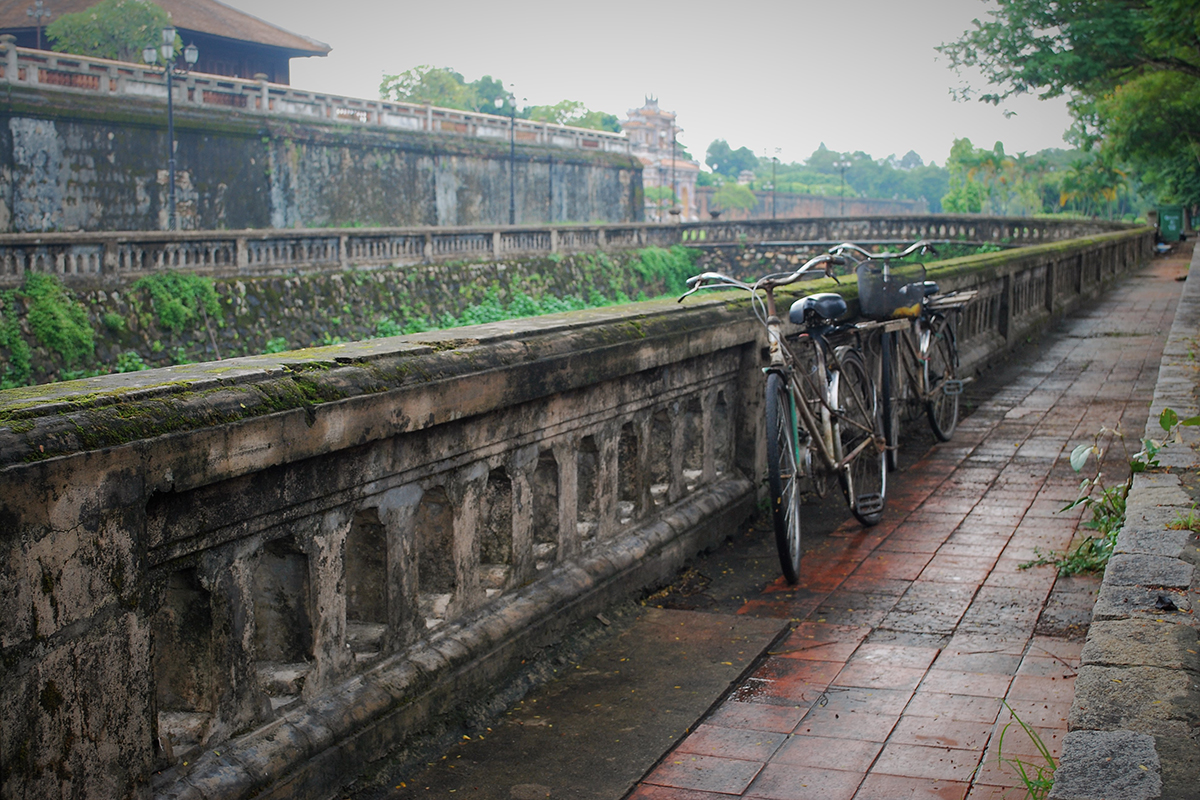
The Imperial City in Hue (Photo: Benjamin Brown)
Covering much of the river’s northern side, The Citadel is comfortably the biggest draw for visitors and the first port of call on what is for most a whistle-stop tour of this vibrant, colonial city. A vast, byzantine maze of crumbling temples, walled courtyards and ornate, immaculately manicured gardens contained within thick, impenetrable walls, The Imperial City sits cocooned at the epicentre of this sprawling complex.
Ghosts of the Past
Wandering along one of the many lavishly decorated wooden-covered walkways as the slanted rain beats down upon the slanted roofs, one is reminded of the sheer weight of history and human suffering brought to bear on this site in decades past. This is not a place of joyous celebration but rather one of sombre reflection for the great losses that have befallen the city throughout the latter half of the Twentieth Century.
Home to the Nguyen Dynasty in the Nineteenth-Century, Huế became the nation’s capital in 1802 and remained so right up until the end of World War Two in 1945. Built in 1833 as a gleaming status symbol for the Nguyen family’s wealth and prestige, The Imperial City functioned as a lookout from which to view ceremonies and troop marches. Two centuries on, much of the place now lies in semi-ruin from the heavy, sustained bombing received at the hands of the U.S. military during the Vietnam War, with numerous bullet holes still visible in its charred and sunken walls.
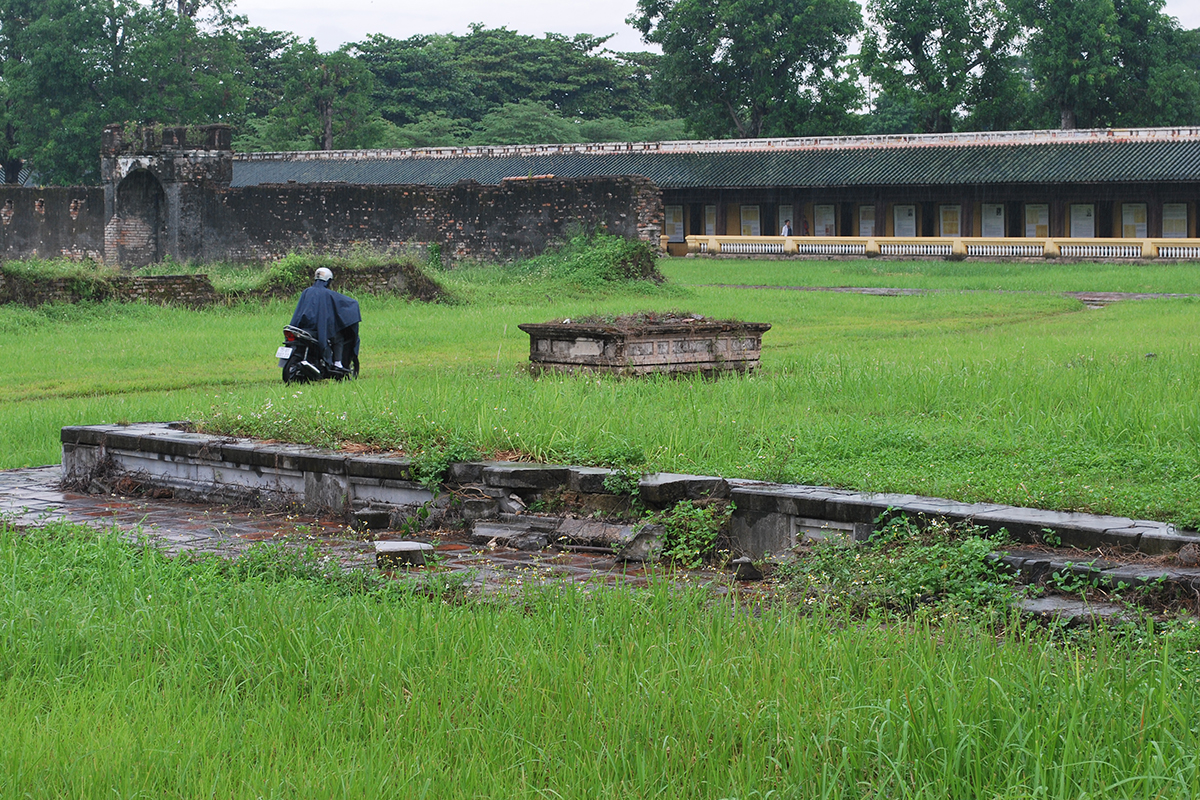
The crumbling ruins of The Imperial City (Photo: Benjamin Brown)
From being among the world’s poorest countries in the late 1970s, Vietnam has since recovered dramatically and is now among the fastest growing economies in Asia. Despite bearing the full force of this upheaval, Huế has been reborn and remodelled as a compact, tourist-friendly time capsule brimming with cultural and political heft.
French Fancies
Whilst considerable portions of The Citadel on the city’s northern banks lie in rubble, the section south of the river, where most of its citizens reside, remains largely intact. Here, the predominant architectural style is French Colonial, in contrast to the traditional Vietnamese sensibilities of The Imperial City, with this influence still felt in some of the city’s more iconic buildings.
Starting at the very end of Lê Lợi street at the intersection of where the Perfume River meets the feeder tributary of sông An Cựu, the cherry red hues of Huế Railway Station (Nguyen Tri Phường Street) certainly stand out amongst the surrounding earth-coloured shanty dwellings. First opened in 1906, with its clean lines and geometric symmetry, the station acts as a regal gateway for passengers stopping off between Hanoi and Saigon, and it is widely considered to be one of the most attractive stations in all of Vietnam.
Cruise the opposite way in the surge of traffic bound for the city centre and you’ll come upon Quốc Học High School (12 Lê Lợi Street), a famed institution who’s distinguished alumni include none other than Vietnam’s idolised former leader, Ho Chi Minh. First founded in 1896, this raspberry-coloured totem of French Colonial architecture is still held as an esteemed place of learning today.
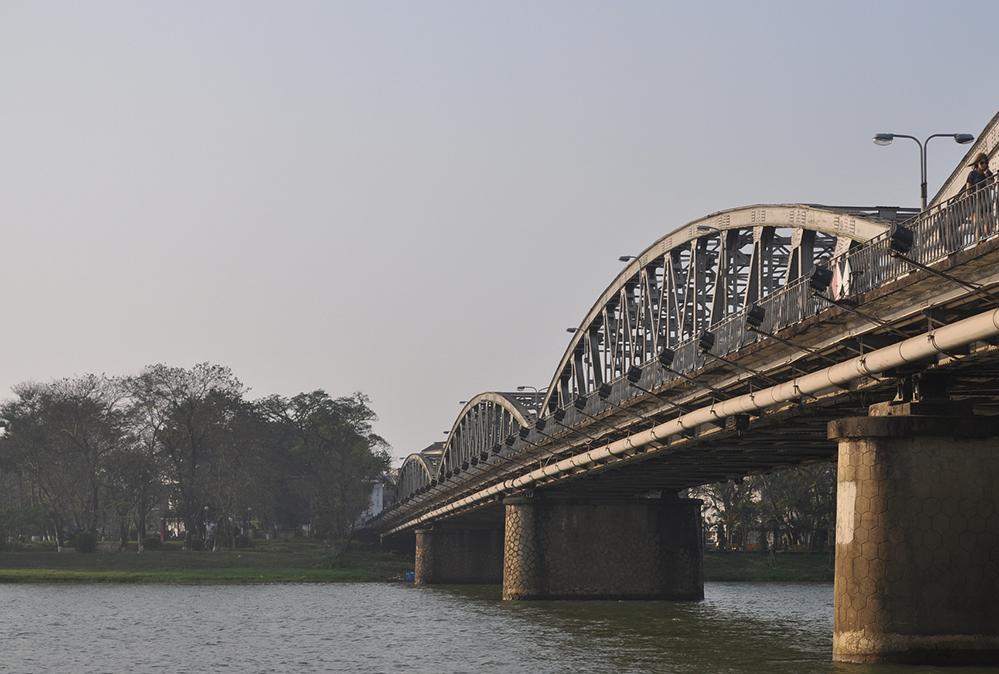
The Truong Tien Bridge (Photo: David McKelvey via Flickr)
Walking down the other end of the long, arrow-straight road of Lê Lợi leads you to the elegant, hemispheric humps of the Truong Tien Bridge. Designed by the legendary French architect Gustav Eiffel and first opened to the public at the turn of the century, the bridge functions as a vital artery connecting north and south. For the multi-arts Huế Festival in 2002, a modern lighting system was first installed along its length, symbolically highlighting how the bridge is an important nexus linking the observed traditionalism of the north with the contemporary aesthetic of the south.
Hotels
Slightly obscured from view down an inconspicuous side-alley and only a five-minute walk from the Truong Tien Bridge, the Alba Hotel & Spa (29 Tran Quang Khai St) is a boutique hotel promising its guests luxury and comfort in abundance. Living up to this promise, the hotel features an indoor spa with water sourced from geothermal springs, a large jacuzzi pool free to use from 4 – 7pm, and plush, ample-sized rooms. Spanning ten individually themed floors, each one of the hotel’s 58 rooms bears its own personalised name.
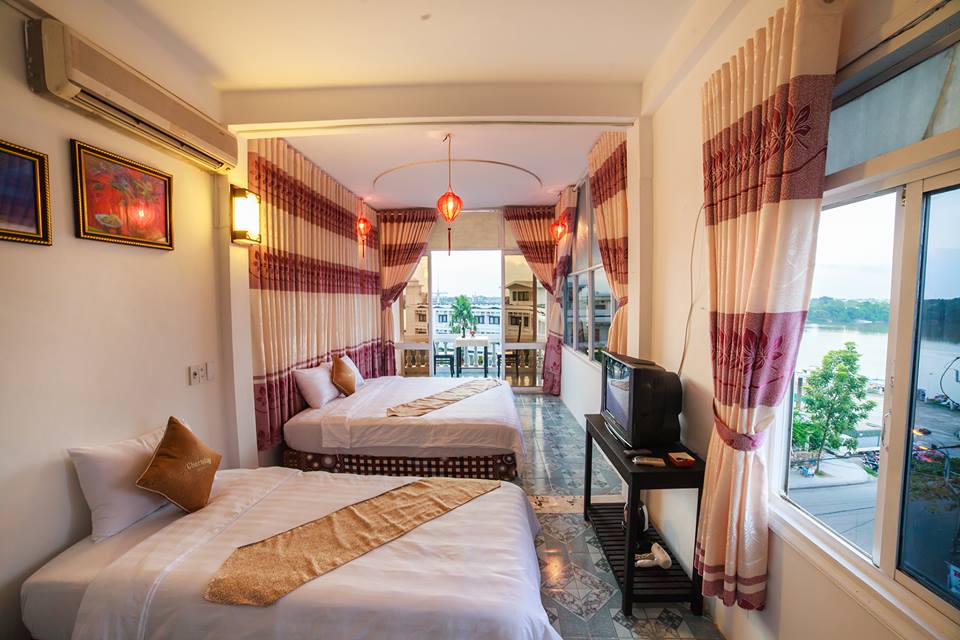
Hue Charming Hotel’s interior (Photo: Hue Charming Hotel)
For those happy to go up a notch or two on their budget belts, Huế Charming Hotel (17 Nguyen Thai Hoc St) puts forward a compelling case. Centrally located in an area teeming with rival establishments, what sets this hotel apart from the competition is the quality of service staff provide to their customers. Attentive and proactive when responding to requests like upgrading or transferring rooms, the staff are as charming as the hotel’s name would suggest.
In the true spirit of hostel living, the Freedom Hostel (42 Nguyen Cong Tru St) provides for its weary travellers a cosy, home-like environment. With special family dinners hosted every evening, a conscious attempt has been made to foster a sense of community and companionship among guests, regardless of creed, colour or ethnicity. The quality of the food at these dinners has also been lauded, whilst the bedrooms are kept clean and well-maintained by a small but dedicated team of caring, conscientious staff.
Cafes & Restaurants
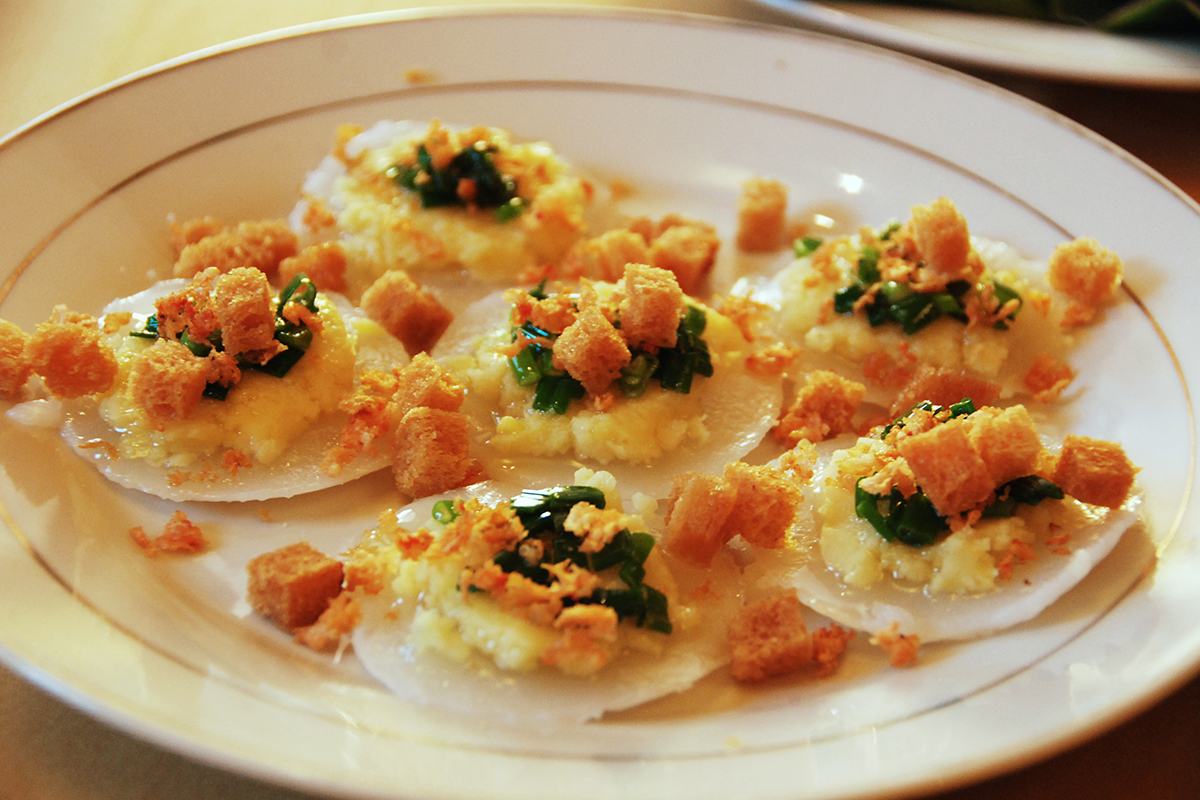
Banh Beo (Photo: Jen Leung via Flickr)
Authentic and a favourite with the locals, the Hanh Restaurant (11 Pho Duc Chinh) affords visitors the ideal opportunity to sample a representative spread of home-grown delicacies as the menu is wide-ranging and extensive. For instance, elect the five-dish set menu option and you’ll be presented with a smorgasbord of succulence, ranging from Banh Beo (steamed rice cakes topped with shrimp) to Gỏi cuốn (spring rolls filled with pork, prawns or vegetables). The general atmosphere is one of harmonious chaos – dishes tend to appear all at once, resulting in a tangle of octopus arms each eager to get their forkful.
Another place frequented by the city’s residents for its authentic Vietnamese cuisine is Tai Phu (2 Dien Bien Phu), located a short distance from the station. Being a little further from the historic centre than many of the city’s more well-trodden eateries, Tai Phu has a more relaxed, less frenetic ambiance that feels more in keeping with the Vietnamese pace of life. That said, service is quick and efficient, with no consequent skimping on quality. The Bun Thit Nuong (grilled pork with vermicelli and herbs), and Beef Pho come highly recommended.
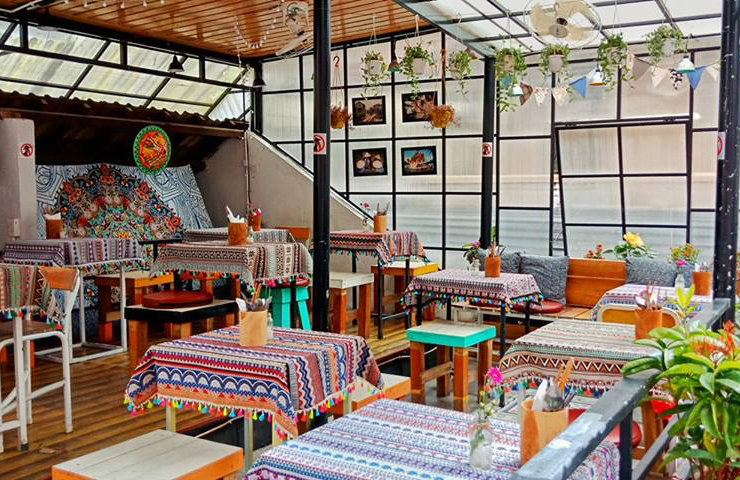
Nook Cafe & Bar’s Interior (Photo: Nook Cafe & Bar)
Living up to its name, Nook Cafe & Bar (7 Nguyen Tri Phuong) is buried away in a nook down a narrow side street in an area packed with no-frills accommodation. Rewarding only the most curious of culinary crusaders, the rooftop terrace area features some striking décor with its brightly patterned tablecloths and multi-coloured chairs. Offering a choice mix of Vietnamese dishes and Western grub, including Vegan burgers and banana crepes, Nook is a family friendly establishment with a laid-back atmosphere aided by background music emanating from the Restaurant’s in-house stereo system.
Adjacent to the Citadel, Hong Mai (65 Nguyen Bieu) is conveniently positioned for those looking to refuel after traipsing the extensive grounds of The Imperial City. Compact in size, the restaurant’s spatial limitations are reflected in the menu, which is by all accounts Spartan. Only two dishes are listed, Banh Khoai (rice crepes filled with pork and shrimp) and Nem Lui (minced pork grilled on lemongrass sticks), yet more than making up for this flagrant lack of choice they are both expertly executed.
Only accessible via Ha Noi street, Nina’s Cafe (16/34 Nguyen Tri Phuong) is hidden away from the main city streets. However, the eventual pay-off is well worth the effort spent staring blankly at a mobile phone waiting for Google Maps to update. With paper lanterns and Asian conical hats dangling from the ceiling, the interior is both cosy and characterful. Service is also lightning-quick, with the Bún bò Huế (soup containing rice vermicelli and beef) & Caramel Clay Pot Chicken scoring particularly highly in the satisfaction stakes.
The Art Market
Translated into English as bamboo paper, truc chi is an age-old practice of making paper from bamboo that has been used to fashion various objects ranging from passport holders to paper lanterns. Situated in the shadow of The Imperial City, Trúc Chỉ Garden (05 Thach Han St) invites you to watch the unfolding process that goes into creating truc chi artwork. Witnessing such actions as the pouring of bamboo pulp mixed with water to create sheets of paper, Truc Chi Garden is especially popular with inquisitive art enthusiasts.
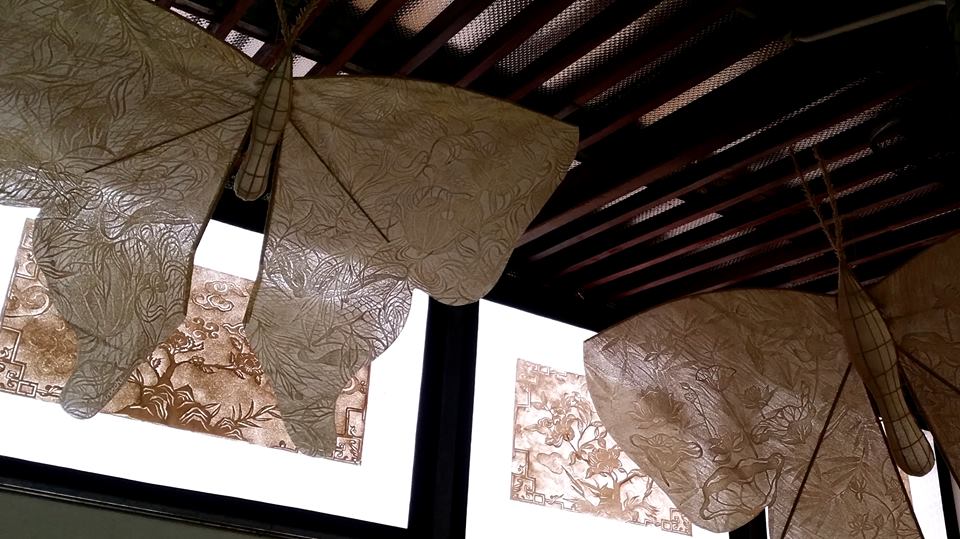
Trúc Chỉ Garden paper designs (Photo: Trúc Chỉ Garden)
Stretched out across two floors, New Space Gallery (28 Pham Ngu Lao) is an independent art space run by twin brothers Thanh and Hai Le, who present a refreshingly contemporary strain of folk art that interweaves traditional oil painting with modern flourishes. Small in size but certainly not ambition, the gallery also features some of their colourful installation work.
Returning to the influence of the French Colonial style architecture, Diem Phung Thi Art Exhibition House (17 Le Loi) is largely overlooked by tourists yet is greatly popular with locals for its extensive permanent collection of 386 works by internationally acclaimed artist Diem Thung Thi. Comprised mainly of abstract, primitive-looking sculptural forms housed both inside the house and dotted around the garden, the works are informed by the fifty or so years Thi spent living in France before resettling in her hometown in Vietnam.
Tinh Hoa Art Shop (6B Vo Thi Sau St) is a small, independent shop displaying delicate traditional handicrafts including woven rattan bowls and jewellery made by local handicapped children. Keychains made from recycled electrical wires are also sold, with profits going towards raising funds for Hope Center Huế, an organisation that provides training and vocational opportunities for disabled people in the surrounding local area.